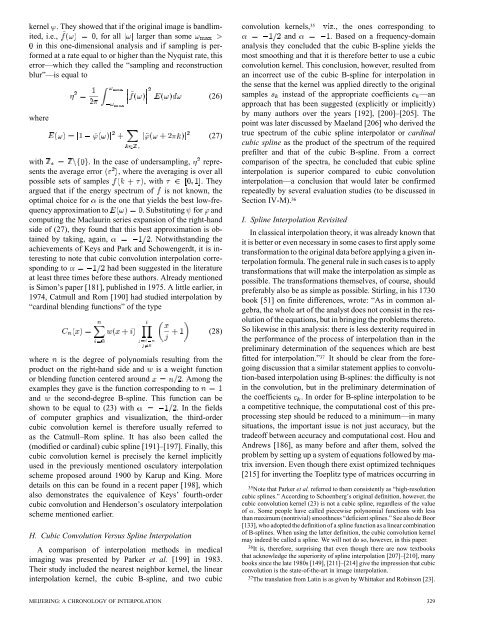from ancient astronomy to modern signal and image processing
from ancient astronomy to modern signal and image processing
from ancient astronomy to modern signal and image processing
You also want an ePaper? Increase the reach of your titles
YUMPU automatically turns print PDFs into web optimized ePapers that Google loves.
kernel . They showed that if the original <strong>image</strong> is b<strong>and</strong>limited,i.e., , for all larger than somein this one-dimensional analysis <strong>and</strong> if sampling is performedat a rate equal <strong>to</strong> or higher than the Nyquist rate, thiserror—which they called the “sampling <strong>and</strong> reconstructionblur”—is equal <strong>to</strong>where(26)(27)with . In the case of undersampling, representsthe average error , where the averaging is over allpossible sets of samples , with . Theyargued that if the energy spectrum of is not known, theoptimal choice for is the one that yields the best low-frequencyapproximation <strong>to</strong> . Substituting for <strong>and</strong>computing the Maclaurin series expansion of the right-h<strong>and</strong>side of (27), they found that this best approximation is obtainedby taking, again,. Notwithst<strong>and</strong>ing theachievements of Keys <strong>and</strong> Park <strong>and</strong> Schowengerdt, it is interesting<strong>to</strong> note that cubic convolution interpolation corresponding<strong>to</strong> had been suggested in the literatureat least three times before these authors. Already mentionedis Simon’s paper [181], published in 1975. A little earlier, in1974, Catmull <strong>and</strong> Rom [190] had studied interpolation by“cardinal blending functions” of the type(28)where is the degree of polynomials resulting <strong>from</strong> theproduct on the right-h<strong>and</strong> side <strong>and</strong> is a weight functionor blending function centered around . Among theexamples they gave is the function corresponding <strong>to</strong><strong>and</strong> the second-degree B-spline. This function can beshown <strong>to</strong> be equal <strong>to</strong> (23) with. In the fieldsof computer graphics <strong>and</strong> visualization, the third-ordercubic convolution kernel is therefore usually referred <strong>to</strong>as the Catmull–Rom spline. It has also been called the(modified or cardinal) cubic spline [191]–[197]. Finally, thiscubic convolution kernel is precisely the kernel implicitlyused in the previously mentioned oscula<strong>to</strong>ry interpolationscheme proposed around 1900 by Karup <strong>and</strong> King. Moredetails on this can be found in a recent paper [198], whichalso demonstrates the equivalence of Keys’ fourth-ordercubic convolution <strong>and</strong> Henderson’s oscula<strong>to</strong>ry interpolationscheme mentioned earlier.H. Cubic Convolution Versus Spline InterpolationA comparison of interpolation methods in medicalimaging was presented by Parker et al. [199] in 1983.Their study included the nearest neighbor kernel, the linearinterpolation kernel, the cubic B-spline, <strong>and</strong> two cubicconvolution kernels, 35 , the ones corresponding <strong>to</strong><strong>and</strong> . Based on a frequency-domainanalysis they concluded that the cubic B-spline yields themost smoothing <strong>and</strong> that it is therefore better <strong>to</strong> use a cubicconvolution kernel. This conclusion, however, resulted <strong>from</strong>an incorrect use of the cubic B-spline for interpolation inthe sense that the kernel was applied directly <strong>to</strong> the originalsamples instead of the appropriate coefficients —anapproach that has been suggested (explicitly or implicitly)by many authors over the years [192], [200]–[205]. Thepoint was later discussed by Mael<strong>and</strong> [206] who derived thetrue spectrum of the cubic spline interpola<strong>to</strong>r or cardinalcubic spline as the product of the spectrum of the requiredprefilter <strong>and</strong> that of the cubic B-spline. From a correctcomparison of the spectra, he concluded that cubic splineinterpolation is superior compared <strong>to</strong> cubic convolutioninterpolation—a conclusion that would later be confirmedrepeatedly by several evaluation studies (<strong>to</strong> be discussed inSection IV-M). 36I. Spline Interpolation RevisitedIn classical interpolation theory, it was already known thatit is better or even necessary in some cases <strong>to</strong> first apply sometransformation <strong>to</strong> the original data before applying a given interpolationformula. The general rule in such cases is <strong>to</strong> applytransformations that will make the interpolation as simple aspossible. The transformations themselves, of course, shouldpreferably also be as simple as possible. Stirling, in his 1730book [51] on finite differences, wrote: “As in common algebra,the whole art of the analyst does not consist in the resolutionof the equations, but in bringing the problems there<strong>to</strong>.So likewise in this analysis: there is less dexterity required inthe performance of the process of interpolation than in thepreliminary determination of the sequences which are bestfitted for interpolation.” 37 It should be clear <strong>from</strong> the foregoingdiscussion that a similar statement applies <strong>to</strong> convolution-basedinterpolation using B-splines: the difficulty is notin the convolution, but in the preliminary determination ofthe coefficients . In order for B-spline interpolation <strong>to</strong> bea competitive technique, the computational cost of this pre<strong>processing</strong>step should be reduced <strong>to</strong> a minimum—in manysituations, the important issue is not just accuracy, but thetradeoff between accuracy <strong>and</strong> computational cost. Hou <strong>and</strong>Andrews [186], as many before <strong>and</strong> after them, solved theproblem by setting up a system of equations followed by matrixinversion. Even though there exist optimized techniques[215] for inverting the Toeplitz type of matrices occurring in35 Note that Parker et al. referred <strong>to</strong> them consistently as “high-resolutioncubic splines.” According <strong>to</strong> Schoenberg’s original definition, however, thecubic convolution kernel (23) is not a cubic spline, regardless of the valueof . Some people have called piecewise polynomial functions with lessthan maximum (nontrivial) smoothness “deficient splines.” See also de Boor[133], who adopted the definition of a spline function as a linear combinationof B-splines. When using the latter definition, the cubic convolution kernelmay indeed be called a spline. We will not do so, however, in this paper.36 It is, therefore, surprising that even though there are now textbooksthat acknowledge the superiority of spline interpolation [207]–[210], manybooks since the late 1980s [149], [211]–[214] give the impression that cubicconvolution is the state-of-the-art in <strong>image</strong> interpolation.37 The translation <strong>from</strong> Latin is as given by Whittaker <strong>and</strong> Robinson [23].MEIJERING: A CHRONOLOGY OF INTERPOLATION 329
















